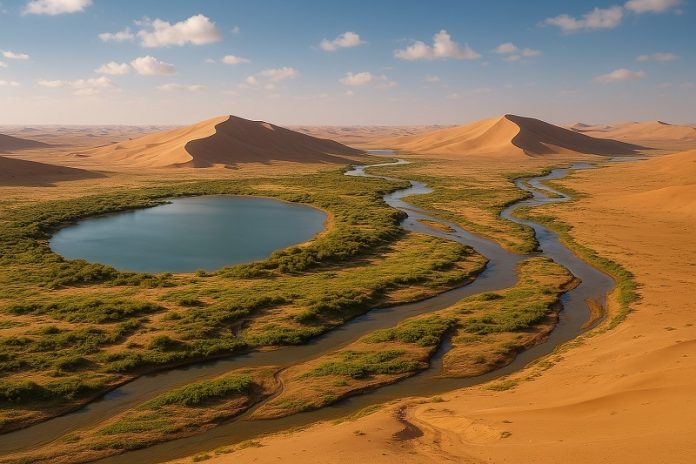
The Arabian Desert, known today as one of the driest places on Earth, was once full of lakes, rivers, and green landscapes.
Around 9,000 years ago, this region experienced heavy rainfall that turned the land into a lush, green environment.
This surprising discovery was made by a team of international scientists who explored the Rub’ al Khali Desert, also known as the Empty Quarter.
The team was led by Dr. Abdallah Zaki and Professor Sébastien Castelltort from the University of Geneva in Switzerland, along with Professor Abdulkader Afifi from KAUST in Saudi Arabia.
They worked together with Professor Michael Petraglia from Griffith University in Australia to study the land and its ancient history.
Their findings were published in the journal Communications Earth & Environment.
The scientists found evidence of an ancient lake, rivers, and even a long valley that had been carved by flowing water. This shows that the desert was once a place with much more rain than it gets today.
According to Dr. Zaki, the lake reached its largest size about 9,000 years ago, during what researchers call the “Green Arabia” period. This wetter time is believed to have lasted from about 11,000 to 5,500 years ago.
The ancient lake was huge—it covered an area of 1,100 square meters and was about 42 meters deep. Professor Castelltort explained that the lake grew so large due to the increase in rainfall that it eventually overflowed.
When it burst, it caused a massive flood that carved out a 150-kilometer-long valley in the desert.
The team believes that the heavy rains came from the African monsoon, which brought moisture from across the Red Sea. This idea is supported by the types of soil and sediment found in the area, which match materials that came from the nearby Asir Mountains.
Professor Petraglia, who studies ancient human life, said the changes in climate would have had a big impact on people living there at the time. The lakes, rivers, and green grasslands would have attracted hunters, gatherers, and early farmers. These groups could have lived off the land and moved across the region more easily.
However, around 6,000 years ago, the rain stopped coming. The area became dry again, and people were forced to move to other places with more water.
Life in the region changed dramatically, and many nomadic groups had to adapt to the new, harsh desert conditions.
This discovery not only shows how much the environment has changed, but also how ancient people adapted to the world around them.



